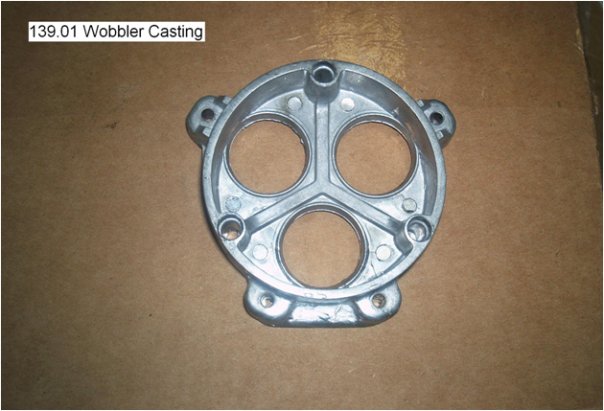Aluminum Housing for Portable Devices. Portable devices, unlike their bigger counterparts, trade strength for portability. This trade-off is necessary to make the devices portable. Thinner and less dense materials are used to reduce the overall weight of the device. This …
Continue reading
500 Die Casting Parts Every Day
How many parts can we make a day? 500 Die Casting Parts a Day.
Kinetic Die Casting Company makes many types of die casting parts. In most cases we make a part a minute. The larger or heavier a die casting part, the slower the production rate. Some of these parts are large roof tile mold castings that are 17″ long.
Aluminum Roof Tile Mold
These roof tile molds are produced one part every two or three minutes or about 250 parts a day in a single shift.
Some of these parts are small clips used in lighting fixtures that are only 1/8″ long. In one case, we make over 3,000 water pump housings in a single day.

Water Pump Housing
Some of our customers order fewer than 500 parts so we produce their purchase order in a single day. Contact Kinetic Die Casting Company to purchase your aluminum parts or zinc parts today. Buy thousands or fewer than 100 parts. Call 818-982-9200.
Kinetic Die Casting manufactures aluminum military parts, aluminum hardware, and aluminum die castings. Visit our website for a quote: Kinetic Die Casting Company
Different Die Casting Alloys for Different Purposes
Different Die Casting Alloys for Different Purposes. There are several die casting alloys that can be utilized to manufacture high grade and tremendously strong metallic parts like Aluminum die casting. Die casting requires the utilization of liquefied alloys which will be injected into molds to create metal parts.
Die casting alloys utilized for metal casting ought to have lower melting point. Alloys that can be thawed simply allows for faster production procedures and guards the die or mold from being injured.
For little metal parts, one of the finest die casting alloys that can be utilized is zinc. Zinc alloy is simpler to cast and have better ductility than other materials. It can also attain high impact strength. Most significantly, zinc alloy can be plated easily.Furthermore, you can use hot chamber zinc die casting, which also impacts the price of the part.
Aluminum on the other hand is very lightweight, simple to melt, and have better artistic qualities. By employing aluminum as die casting material, manufacturers can produce parts at a faster rate and can make parts like aluminum die cast boxes. That is because aluminum is very stable at high temperature and will cool faster thus reducing the threat of contamination and oxidation. Because of these, aluminum alloys can oppose corrosion better than other materials.
Other kinds of die casting alloys that are appropriate to use for high pressure and high temperature castings are magnesium, copper, lead and tin. Magnesium is the lightest alloy that can be utilized for casting while copper offer greater strength and high resistance to corrosion. Magnesium alloy is also inexpensive and easier to machine after production. Tin and lead on the other hand can be used to produce near finished parts.
Kinetic Die Casting manufactures a lot of aluminum rooftile plates , trim tile molds, and military die casting. If you would like a quote, please visit our website: Kinetic Die Casting Company
Compare Extruded Aluminum Heat Sinks to Die Castings
Aluminum is the preferred material used to produce heat sinks because of aluminum’s thermal conductive properties, the weight of the many aluminum alloys and, the natural electrical conductivity of aluminum.
EXTRUSIONS AS HEAT SINKS:
Initially, heat sinks were produced as extrusions. The extrusion process is to heat aluminum to a point just before melting temperature and then “squeeze” or extrude the aluminum through a form creating long aluminum sections that will need to be cut into the proper part lengths. Then the part is machined for mounting holes and other features. There is wasted aluminum because the material cut away cannot be used in the extrusion process again. Also, many times the lengths have left over amounts that are too short to be used to make parts.
DIE CASTINGS AS HEAT SINKS:
In the die casting process, we inject aluminum into a die forming the heat sink. As a die casting part, the mounting holes and special features can be die cast into a “net shape” part. There is not wasted aluminum in the die casting process because the excess aluminum is remelted and used to form additional parts. Also in the die casting process, there are no “left over” sections.
ADVANTAGES OF DIE CASTING HEAT SINKS:
1. Machining holes and features is not necessary saving money in the production process.
2. Time is saved in manufacturing because machining is not necessary.
3. No wasted aluminum.
Kinetic Die Casting Company produces many types of aluminum heat sink parts. Contact Kinetic Die Casting Company to purchase your die casting parts or die casting tooling.
Kinetic Die Casting Company
6918 Beck Avenue North Hollywood, California, 91605, USA
800-524-8083 or 818-982-9200 or fax 818-982-0877
Kinetic Die Casting manufactures aluminum and zinc die casting parts. Samples of KDC’s work include die cast speaker parts, aluminum tile plates, and other die cast metal parts. If you would like to have a quote please visit our website: Kinetic Die Casting Company
Kinetic Die Casting Company Production Parts Limitations
KDC Limitations. Kinetic Die Casting Company Production Parts Limitations.
Kinetic Die Casting Company has some limitations on the size, materials and quantities of production parts we will manufacture.
SIZE: Diecasting Part Weights and Sizes
Part sizes from .001 pounds to 10 pounds.
Part sizes range from .025″ x .025″ (smallest).
Part sizes up to 15″ to 17″ (largest)
Surface area up to about 200 square inches.
READ MORE:
KineticDC Size Limitations http://www.kineticdiecasting.com/capabilities.html
MATERIALS: Diecasting Materials or Alloys
380 Aluminum Diecasting Alloy.
383 Aluminum Diecasting Alloy.
360 Aluminum Diecasting Alloy.
413 Aluminum Diecasting Alloy.
#3 Zinc (Zamak 3) Die Casting Alloy.
READ MORE: KineticDC Die Casting Alloys
http://www.kineticdiecasting.com/casting_aluminum.html
QUANTITIES: How Many Die Casting Parts Each Order
We will produce fewer than 100 parts.
As many a 10,000 parts per delivery.
No more than 250,000 parts per year.
DIE CASTING TOOLING: We Make Die Casting Tooling
KDC makes die casting tooling for our customers inexpensively so that when they need a few die casting parts, we can make those parts for them.
Send us a RFQ (Request for Die Casting Quote)
http://www.kineticdiecasting.com/replyform.html
Kinetic Die Casting, Inc.
6918 Beck Avenue, Aluminum
North Hollywood, CA 91605
Toll Free: (800) 524-8083
Local: (818) 982-9200
Fax: (818) 982-0877
Sales@kineticdc.com
Look at our Die Casting Blog for information every day
Kinetic Die Casting is located in North Hollywood,California. KDC specializes in manufacturing zinc and aluminum alloy casting parts. If you would like a quote, please visit our website:Kinetic Die Casting Company
Which is the Right Die Casting Alloys
Which is the Right Die Casting Alloys. Choosing the alloy right for a component counts among the main concerns for casters and designers of die cast parts. They ought to be not only being well-versed on the different properties of die casting alloys. Their information should go further than the cost of each material and expand to a systematic examination of the drawbacks and rewards of each alloy. The thin walls and sections, for example, of a special design would need metals of better strength and fewer cubic inches.
Basically, there are six die casting alloys for deliberation. These are: aluminum, zinc, magnesium, copper (bronze), lead, and tin. The more scientific specifications of die casting alloys cover: zinc aluminum, AZ91D magnesium, ZAMAK alloy, AA 380, AA 384, AA 386, and AA 390. The exacting characteristics of each of these materials for die casting offer definite compensations for the designed component.
Aluminum, for instance, is light but possesses high dimensional constancy suitable for complicated designs and thin walls. It is corrosion-resistant, with great mechanical properties, high electrical and thermal conductivity, and retains strength even at high temperatures. Zinc, in contrast, enjoys the benefits of being simple to cast among other materials with its low melting point. It could be counted on for high impact strength and high ductility for a long-lived die. Simply plated, zinc materials stand as the finest die casting alloys for small parts.
Machining would be the simplest if magnesium is utilized as die casting alloys. Although it is the lightest alloy to die cast, magnesium boasts of a strength-to-weight ratio benefit. High hardness could be copied from copper, as well as high resistance to corrosion. With its mechanical properties highest among die cast materials, copper is wear-resistant, dimensionally stable and strength near that of steel components. High density is what lead and tin alloys bring to the die caster. They are the well-matched die casting alloys for components with tremendously close dimensions and those that require to be particularly corrosion-resistant.
Kinetic Die Casting is a die casting company specializing in aluminum and zinc parts. If you would like to request a quote, please visit our website:Kinetic Die Casting Company


